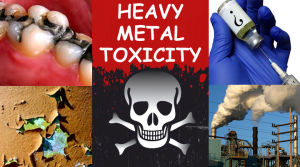Rise in environmental pollution of air, food, water, and cosmetics with mercury, lead, cadmium, aluminum, arsenic, and other toxic metals is becoming increasingly recognized as a significant contributing factor of many chronic inflammation-based diseases.
These chemicals damage cells and tissues both by direct toxic effects as well as by interfering with the function of important nutrient metals  including calcium, potassium, magnesium, zinc, iron, and copper. Although toxicity from a single exposure is quite rare the toxic effect of gradual low levels of exposure is now appreciated to be a common occurrence in many individuals. Diagnosis of heavy metal toxicity is somewhat controversial. Blood testing misses many cases not associated with high-level recent exposure. Heavy metals often accumulate in tissues like the brain, liver, kidneys, and immune system. A more sensitive method to detect the presence of heavy metals involves the measurement of heavy metals in urine following the administration of a chelating agent designed to transiently increase mobilization and clearance.
including calcium, potassium, magnesium, zinc, iron, and copper. Although toxicity from a single exposure is quite rare the toxic effect of gradual low levels of exposure is now appreciated to be a common occurrence in many individuals. Diagnosis of heavy metal toxicity is somewhat controversial. Blood testing misses many cases not associated with high-level recent exposure. Heavy metals often accumulate in tissues like the brain, liver, kidneys, and immune system. A more sensitive method to detect the presence of heavy metals involves the measurement of heavy metals in urine following the administration of a chelating agent designed to transiently increase mobilization and clearance.
The symptoms of heavy metal toxicity can mimic the symptoms of many different chronic diseases and toxic metals often act together with other disease-causing factors like chronic infection and nutrient deficiency.
Although it is important to learn to recognize the symptoms of heavy metal toxicity, tissue levels are often quite high before symptoms are appreciated. Symptoms include cramps, numbness, tingling, tremors, muscle tics and twitches, memory loss, confusion, impaired language skills, loss of coordination, abnormality of gait, anxiety, depression, headache, digestive problems, nausea, vomiting, difficulty breathing, fatigue, night sweats, deteriorating vision, unexplained weight gain or loss, aching joints, body aches and pains, hair loss, impaired blood sugar regulation, frequent colds and flus, unexplained skin rashes, insomnia, low body temperature, bleeding gums, sensitivity to chemicals and odors, menstrual irregularity, infertility, and miscarriage. Diseases associated with heavy metals include peripheral neuropathy, Parkinson’s, dementia, epilepsy, autism, kidney failure, liver cirrhosis, diabetes, alopecia, pulmonary fibrosis, and vitiligo.
Avoidance of exposure is the important first step in recovery from the toxic effects of harmful heavy metals like lead and mercury.
Start reading labels of personal skin and hair care products and avoid products known to contain aluminum and other harmful chemicals.  Drink lots of purified or mountain spring water. Avoid cooking with aluminum and teflon. Certain hobbies and vocations are known to be associated with a marked increase in toxic metal exposure like hair-dressers, welders, potters, farmers, stained glass workers, and painters.
Drink lots of purified or mountain spring water. Avoid cooking with aluminum and teflon. Certain hobbies and vocations are known to be associated with a marked increase in toxic metal exposure like hair-dressers, welders, potters, farmers, stained glass workers, and painters.
Regular supplementation of appropriate doses of often deficient nutrient minerals like magnesium, zinc, and potassium can help to reduce the toxic effect of harmful heavy metals.
If you suspect symptoms of heavy metal toxicity or have been diagnosed with elevated and potentially toxic levels of these metals it is important to take active steps to support detoxification metals designed to assist the body in eliminating them in order to avoid and even reverse their toxic effects. At Forum Health Austin we are very aware of the role that toxic heavy metals play in chronic disease and we have protocols that are designed to diagnose and treat this frequently seen problem. Contact us today to schedule an evaluation.









